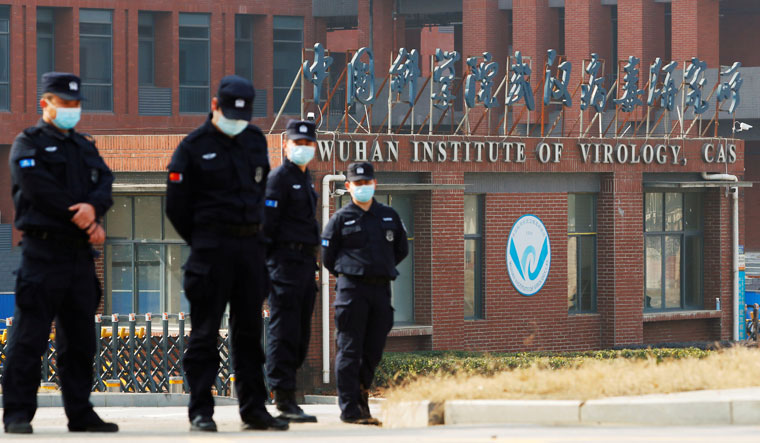Leaders of the world have suddenly taken an interest in the other theories on the origin of Covid19 virus. This article seeks to throw some light on the origin of the causative agent behind Covid19. It would examine the studies on the near relatives of SARS-CoV-2 virus, the Furin Cleavage site and the issue of changing the name of a related virus by Wuhan Institute of Virology. It will take a peek into the Furin cleavage site, genomics and spike protein structure of SARS-CoV-2 & related viruses
Also See: Cyber warfare from China-part-II
On a genomic level, the Coronavirus which caused the pandemic and is designated as the SARS-CoV2 is a chimera of Coronaviruses found inside bats and pangolins. The genome of ‘Covid19 causing pathogen’ is a combination of two genomes.
Taxonomically, SARS-CoV-2 virus is classified as a member of the species SARS-related coronavirus (SARSr-CoV) in the genus Betacoronavirus of the family Coronaviridae. Researches were carried out by various groups on the genome. SARS-CoV-2-related viral genome sequences from bats have been reported from Eastern China and Japan, and from pangolins in China.
The prevalent opinion about the origin of Covid19 has been quite simple. A pangolin and a bat came in close proximity to one another, and that led to transmission of Coronavirus from one species to another, which led to genesis of a particular zoonotic variant. And due to that the disease jumped to human population.
RaTG13 and PCoV are bat and pangolin coronaviruses related to SAR-CoV-2. These viruses are found in bats and pangolins respectively. PCov_GX represents the name of the coronavirus found in pangolins of China’s Guangxi province.
There have been studies on cryo-Eelecton Microscopic structures of spikes from bat (RaTG13) and pangolin (PCoV_GX) coronaviruses. These studies have shown that the spike glycoproteins of bat Coronavirus and pangolin Coronavirus are related to the spike protein on the surface of the SARS-CoV2 virus. Studies have also shown that the conformational structure of the spike protein’s Receptor binding domain is important for the virus evolve to attain highly efficient infection.
The Coronavirus is structurally related to the SARS virus and the MERS virus (Middle East respiratory syndrome virus).
There is a lot of data on origin of the causative pathogen of Covid19. This collective data suggests that like SARS-CoV and MERS-CoV, SARS-CoV-2 likely originated in bats and eventually spread to humans following evolution in intermediate hosts. Coronavirus (RaTG13), detected in the horseshoe bat Rhinolophus affinis in China’s Yunnan province has been identified as the closest relative of the SARS-CoV-2. This virus shares 96.2% sequence identity with the SARS-CoV-2 genome. This striking similarity reflects the likely origin of SARS-CoV-2 in bats. Coronaviruses found in Pangolin (PCoV) are closely related to SARS-CoV-2. These Pangolin-coronaviruses have also been identified in smuggled Malayan pangolins (Manis javanica) in China’s Guangxi (GX) and Guangdong (GD) provinces. Analyses of six PCoV_GX and four PCoV_GD genome sequences were carried out. They indicated a high level of similarity with SARS-CoV-2 (85.5% to 92.4% sequence identity). The natural reservoirs and intermediate hosts of SARS-CoV-2 hence show huge similarity in terms of viral genome sequences of the viruses that they carry. Natural and intermediate hosts of Coronavirus remain a topic of debate, and it is still largely unclear how SARS-CoV-2 evolved to infect humans.
Among the recently circulating mutant forms of the Coronavirus, the delta mutant, labelled as variant of concern by the WHO has atleast four mutations on the spike protein. These four mutations are L452R, P681R, D614G, and T478K.
Mutations are basically changes in “which amino acid is being produced” leading to a change in the structure and function of the protein. The letters L, P, R, D, G, T & K represent the symbols of amino acids forming proteins like Spike protein. The number represents the position of the amino acid where the mutation takes place. When codon for an amino acid (represented by the first letter) at that particular site changes, that changes the amino acid itself into a different one (represented by the second one). This is how the mutations are designated. Mutations are of many kinds with respect to the location of the genes on the viral genome. These changes are driven by the evolutionary pressure on the Coronavirus as it spreads across the planet. The mutations are driven by the need of the virus to survive and thrive.
Also Read: Invisible and enigmatic scare the most
Mystery of Furin cleavage site in SARS-CoV-2-was it artificially inserted?
The mystery of the Furin cleavage site in the spike protein of Coronavirus is intriguing. On a cellular level, a coronavirus (CoV) infects the target cell by either cytoplasmic or endosomal membrane fusion. The final step of viral entry involves the release of RNA into the cytoplasm of the host cell for replication irrespective of what path it chooses. Hence, the fusion capacity of the Coronaviral Spike protein (CoV-S) is a leading indicator of infectivity of the virus under consideration.
Origin of the SARS-Cov-2, which is ravaging the globe, is linked to the emergence of the novel Furin cleavage site in the viral spike glycoprotein. Furin is a serine protease widely expressed in human cells that cleaves the SARS-CoV-2 spike at the interface of its two subunits. A gene on chromosome 15 in human genome encodes Furin. Presence of Furin cleavage site in influenza virus is linked to its high virulence rate. It has been found that SARS-CoV-2 has the insertion of FCS, which is absent in its natural predecessor, which is SARS-CoV.
Bioinformatic study has alluded to the mystery of the insertion of FCS in the new ravaging Coronavirus which has taken the proportion of a pandemic. This approach uses the genomic data available on the National Centre for Biotechnological Information (NCBI) databases, to identify the origin of the Furin cleavage site.
Studies have not been able to point out exactly how the FCS got inserted in the Spike protein of the SARS-CoV-2. The mystery of the SARS-CoV-2 gets more intriguing when looked at with its closest relative RaTG13 detected in the horseshoe bat.
Game of Name-changing by Wuhan institute of Virology
Researchers at University of California San Diego School of Medicine, with colleagues at the University of Arizona and Illumina Inc., have studied the SARS-CoV-2 virus. It was estimated that the virus was likely circulating undetected for at most two months before the first human cases of COVID-19 were described in Wuhan, China in late-December 2019.
In November 2019, 3 researchers from China’s Wuhan Institute of Virology became sick enough that they sought hospital care. This was disclosed by a previously undisclosed U.S. intelligence report. This report can add weight to growing calls for a fuller probe of whether the Covid-19 virus may have escaped from the laboratory. China has vehemently denied such claims.
Reports by intelligence agencies can be blamed of pandering to the views of their immediate political bosses in Washington and London. But, the picture is murkier inside WIV itself. There is something dubious about studies of WIV on horse-shoe-bat virus RaTG13 which has 96.2% genomic similarity with the pandemic-causing virus SARS-CoV-2. WIV has given very limited information on RaTG13, although it had stated that its samples were collected from Yunnan in 2013. It stated that it had worked on the complete genome of RaTG13 only after the outbreak. It was found out that the name of the virus RaTG13 was changed prior to publication of a crucial paper. The actual name of the virus was RaBtCoV/4991, on which WIV had published researches in 2016 and 2018. It was also found out that the genomic similarity between RaTG13 and SARS-CoV-2 is 98.9%.
Here comes a starter to a big revelation! In an emailed reply to the journal Science, WIV had accepted that the name was changed from RaBtCoV/4991 to RaTG13. WIV had stated that its labs had worked on the samples in 2018 and no more samples were left after the 2018. This raises another important question. If WIV did not have samples after 2018, how did it carry out genomic studies on it after the outbreak, as it had claimed?
Also See: New mutants of Coronavirus
Lab-leak theory gaining steam
Over the past week, lab-leak theory has gained steam as Joe Biden ordered US intelligence community to dissect out the origins of Covid19. It is now becoming clear that many others have been digging into the precise origin of Covid19 through various means. A group of social media detectives with backgrounds in science have been leading efforts to uncover clues about the origins of the SARS-CoV-2 virus, particularly if it leaked from a lab in Wuhan. This group of 24 people that calls itself DRASTIC or Decentralized Radical Autonomous Search Team Investigating Covid-19, began looking into clues from Chinese scientific databases shortly after the pandemic began.
In a parallel development, a research paper by British professor Angus Dalgleish and Norwegian scientist Dr Birger Sorensen came into the spotlight. Citing this paper, a British daily newspaper made a stunning claim. It reported that the novel coronavirus SARS-CoV-2 virus has no “credible natural ancestor” and was created in the Wuhan lab by Chinese scientists working on a “gain of function” project.
This shows that there is a lot more to the Covid19 crisis than what meets the eyes. And, instead of solving the mystery of the origin of Covid19, the dots of “FCS site”, & especially the name-changing by WIV make it even more complicated.





